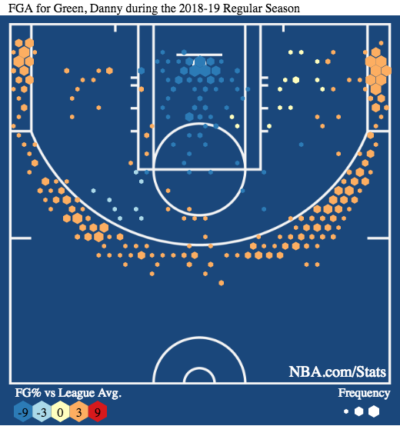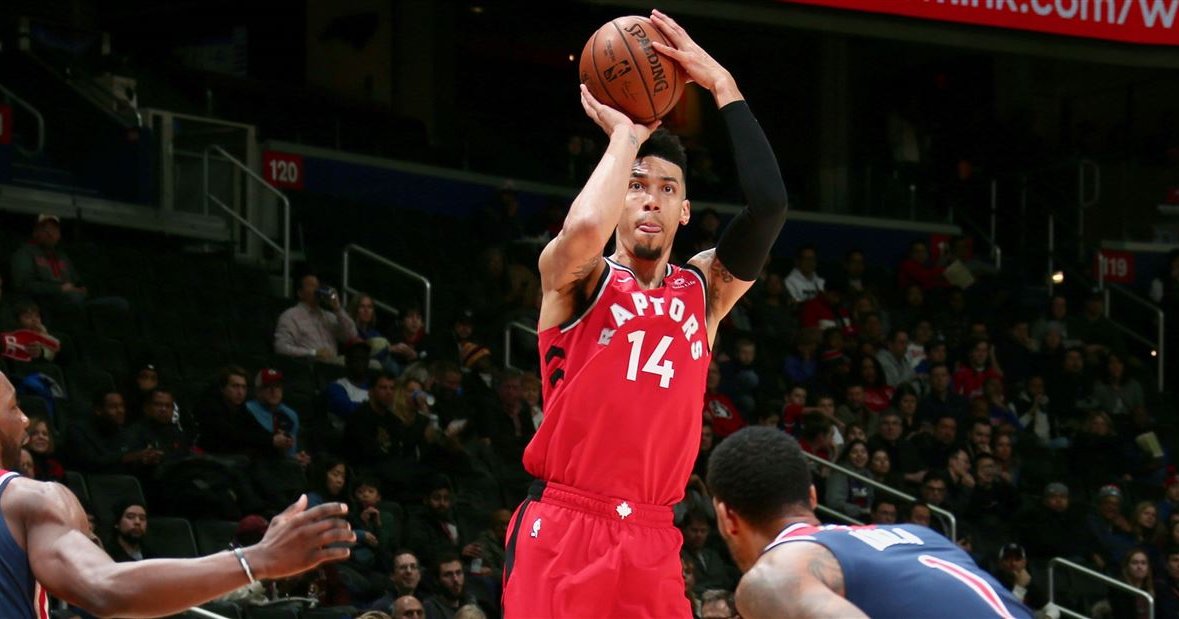Danny Green was arguably the most consistent Raptor throughout the 2018-19 regular season, helping the team achieve a 58-24 record and the 2nd seed in the Eastern Conference.
Despite being considered a “throw-in” in the Kawhi Leonard-DeMar DeRozan trade by some pundits, it became clear very quickly that Green would be more than that for a contending Raptors team. He would also be missed in San Antonio, an organization that never truly valued his play and desperately lacked shooting last season.
From the jump, Green was a perfect fit in the Raptors starting lineup next to backcourt mate Kyle Lowry. Green was immediately a catch-and-shoot threat who spaced the floor and thrived defending bigger guards, allowing Lowry to do what he does best: facilitate and defend smaller guards.
Green thrived in a Raptors system that prioritized ball movement, had several facilitators on the floor at any given time, and generated clean three-point looks both in the half-court and transition. He shot 46.4 percent from the field and 45.5 percent from three on 5.4 three-point attempts per game, the best shooting percentages in his 10-year career. He also averaged 10.3 points per game.
It’s one thing to space the floor but it takes more than that to help a team on a night-to-night basis. Green, a smart veteran who grew up in a disciplined Spurs system, did something backup shooting guard Norman Powell struggles with: he let the game come to him. Green rarely tried to overdo it on offense because he understood that the Raptors had far more talented players like Leonard and Pascal Siakam who could create their own shots or generate good looks for teammates. Instead of trying to do those things himself, Green was happy to spot up from behind the arc where he was a catch-and-shoot threat and cut to the rim when the opportunity presented itself. In fact, Green shot less than eight field-goals per game last season, most of which were threes, and because of his picky shot selection, he had an effective field goal percentage of 62.2, another career-high.

Green also played 80 of 82 games and started all 80, more than any other Raptor. He had a special chemistry with Leonard that they developed from their years playing together with the Spurs, and the two of them always seemed to know where to find one another on the floor. When Leonard was resting, either on the bench or sitting due to load management, Green made life easier for the rest of his teammates by opening up the floor and creating room for teammates to go to the rim. Green also took care of the ball despite being a poor dribbler, committing just 56 turnovers throughout the entire season.
Despite losing a bit of a step from his early years in the league, Green was still a solid defender in his season with the Raptors. Green was a pillar of stability in the Raptors defense throughout the regular season, often tasked with guarding the best perimeter players on the opposing team while playing great team defense, helping, communicating, and constantly improving a Raptors defense that ranked 5th in the league.
While Leonard — a generally quiet and reserved person — largely kept his feelings about Toronto and the Raptors to himself, Green was open about his passion for the city and the organization from the get-go. He co-hosted a podcast with Yahoo Sports Canada, Inside the Green Room, where he brought fans into the life of a Toronto Raptors player, talking to teammates and people around the organization about how much he enjoyed being a part of the Raptors and living in Toronto. Although in many markets that kind of behaviour is common, it means a lot coming from an ex-Spur who seemed to genuinely enjoy his time in Toronto more than most past players did, opening a lot of eyes to the developing basketball scene in Toronto.
Fortunately for Green, he was in the perfect system to highlight his strengths like shooting, transition defense, and help defense while mitigating his weaknesses such as dribbling, creating his own shot, and defending players with size and speed. Those weaknesses, however, did get exposed in the playoffs when the Raptors shortened their bench and depended on Green to continue his regular-season consistency against more talented teams who were game-planning for the Raptors.
Green struggled in the playoffs. Despite shooting 44.1 percent on 2.5 three-point attempts from 6+ feet (wide open) per game in the playoffs, his shooting fell off dramatically when guarded more closely. He shot just 17.1 percent on 1.5 three-point attempts from 4-6 feet (open) and 20.0 percent on 0.8 three-point attempts from 2-4 feet (tight), compared to 44.5 percent and 36.5 percent in the regular season, respectively. He shot just 32.8 percent from three throughout the playoffs, scoring just 6.9 points per game.
His poor playoff numbers are reflective of a number of things: Defenses were more keyed-in on the Raptors, and therefore forced more contested shots and more shots at the end of the shot-clock that Green was uncomfortable taking. Green was also given a shorter leash in the playoffs; whereas Nick Nurse had a fairly regular substitution pattern in the regular season, he was quicker to pull guys in the playoffs after just a few minutes if they weren’t performing, which could have harmed Green’s ability to get into a rhythm. To be fair to Nurse, though, Green was flat-out cold in the Bucks series, shooting just 18.8 percent from the field. Still, his ability to historically knock down open shots forced defenses to spread out and defend him at the three-point line, opening driving lanes for teammates.
Green’s defense also fell off in the playoffs, which could have been in part due to fatigue he suffered from playing so many games in the regular season and playoffs combined at age 31. Although he continued to play solid team defense while opening and closing most games for the Raptors, Green had trouble staying in front of speedy players far too often, allowing opposing players to get to the paint and causing the defense to collapse and scramble, often leading to open looks for the opposing team. His inability to dribble or make the right pass in pressure situations was also exposed, ultimately leading to a turnover in game 6 of the NBA Finals against the Warriors that could have been detrimental.
https://www.youtube.com/watch?v=Er1X1veuV0Q
Despite his playoff shortcomings, Green still had a few memorable games such as game 5 of the 76ers series where he had 17 points (5-for-8) in a 36-point win and game 3 of the NBA Finals where he had 18 points (6-for-10) in a 14-point win. He also shot better than 36 percent from behind the arc in each of those two series’ and was an important cog in the Raptors suffocating defense throughout the postseason.
Green’s consistency as a shooter and team defender, as well as his championship pedigree, ultimately helped him get paid this offseason. However, it wasn’t until Leonard decided to sign with the Clipper that Green finally accepted a two-year, $30 million contract with the Lakers late in free agency. Green’s first choice was to re-sign with the Raptors, but Leonard’s decision to move to Southern California made running it back impossible.
Parting ways with Green could be a blessing in disguise for the Raptors, though. The team is entering a youth movement where their young players will be given more opportunity to shine and roster spots will be prioritized for players with potential. Green, though he would have added much needed shooting to next season’s roster, is entering his thirties and the declining stage of his career in terms of athleticism. Last season proved that Green needs to be in a system that makes life easy in order for him to thrive and mitigate his weaknesses. The Raptors wouldn’t have been able to offer that next season. Fortunately for Green, however, he will be in the perfect situation in LakerLand due to all the double-teams LeBron James and Anthony Davis will receive. He will also have another opportunity to compete for a championship.
All in all, Green was an integral part of the Raptors 2019 NBA championship. He provided much-needed floor spacing and was a lethal three-point shooter for the entire regular season and stretches in the playoffs. He also played great team defense and was a glue-guy who helped merge the veterans and young players. For a role player who had just one year to make his mark on the Raptors, Green outperformed all expectations and will forever be appreciated for helping bring a championship to Toronto. His time with the Raptors has come to an end, though, and both sides should be happy to part ways and move on to the next chapter.



